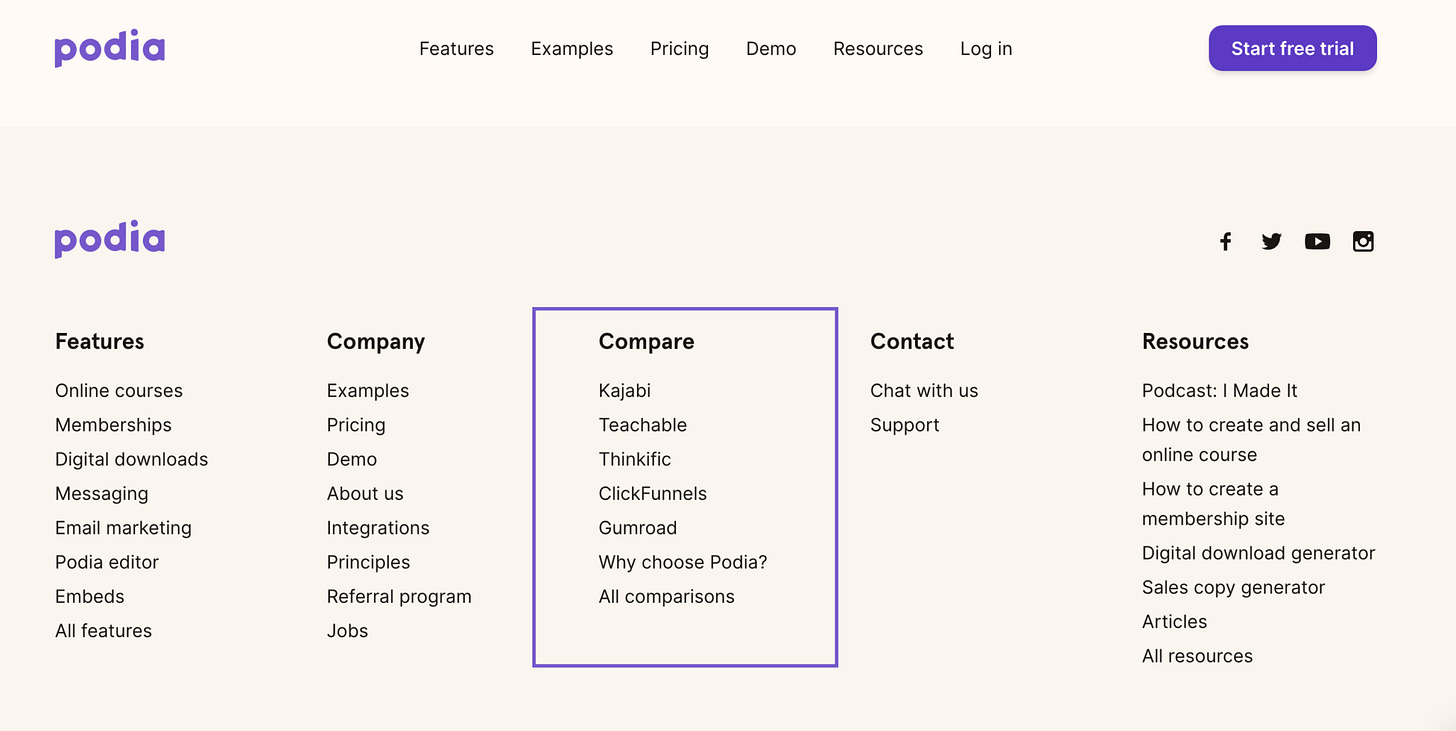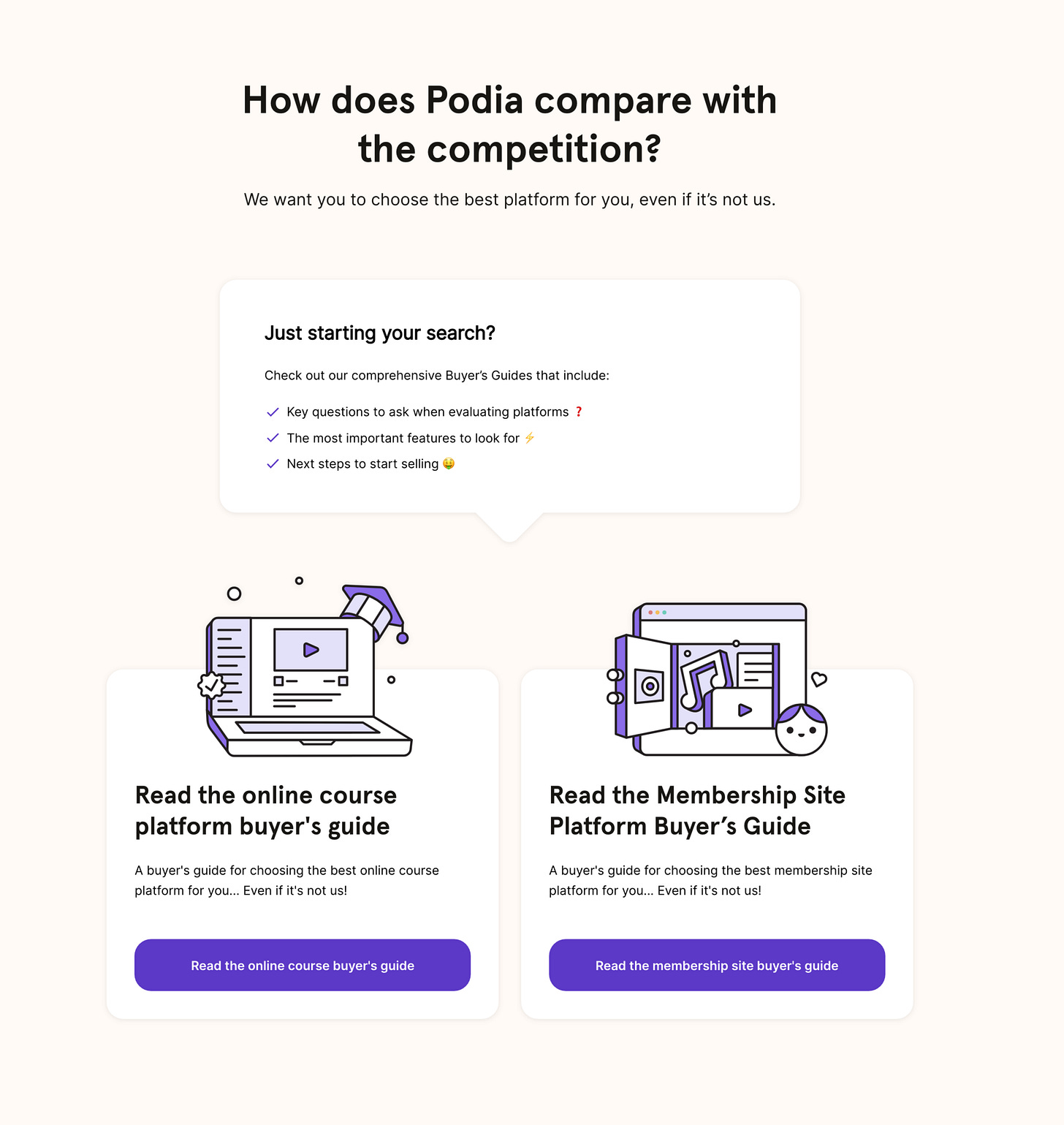Positioning Your Startup
Exploring the benefits of mentioning alternative solutions in your communication
Rule 1:
If your customer does not mention the competition then neither should you. Never discuss the competition in any way unless you have to. Just carry on with your sales presentation as if they do not exist.
Above is the number 1 rule you’ll find in most sales playbook but also the general implicit guideline about competitors in marketing.
For startups, it’s the norm for founders to use competition slides in their pitch decks when meeting with investors. But elements of these analyses are rarely found outside of the boardroom.
If this information is so essential for investors couldn’t it also help potential customers to make a more informed decision? Why hiding the alternatives when they represent the only point of reference?
In this essay, I will not encourage you to start an advertising war à la McDonald’s and Burger King. Instead, I will describe how some successful startups like Figma, Ghost, or Notion intelligently mention their competitors in their communication and how you could do it too.
The psychology and behavioral bias behind new product adoption
When Steve Jobs introduced the iPhone in 2007, he spent more time talking about the incumbents than touting the benefits of Apple’s new product.
In fact, he used the same approach when launching the iMac and the iPad. Why would he do that? Weren’t these products so much better than the competition anyway? Well, Jobs was a genius salesman and a master at understanding consumer psychology. He was well aware of the often-overlooked psychological costs associated with behavior change.
Many products fail because of a universal, but largely ignored, psychological bias: People irrationally overvalue benefits they currently possess relative to those they don’t. The bias leads consumers to value the advantages of products they own more than the benefits of new ones. It also leads executives to value the benefits of innovations they’ve developed over the advantages of incumbent products.
John T. Gourville (Harvard Business Review, 2006)
Consumers evaluate new products based on a reference point. Your startup is only as good or as bad as what the user is comparing it to.
Take Figma for example, the first browser-based and real-time collaborative tool for design professionals, and arguably a much better solution than anything else currently available.
Problem? Their target audience developed long-time habits using tools like InVision, Sketch, or Framer throughout their careers.
To win them over, Figma created a compare section on their website in order to educate them about the product's key differentiators.
Mission accomplished! Figma is the fastest-growing tool in that category.
The upside of capturing comparison searches for user acquisition
As described in my previous post SEO for early-stage startups, ranking on Google for comparison and alternative search terms within your industry can be a very valuable user acquisition channel compounding over time.
Because it’s taboo for most companies to mention their competitors, these search terms are generally dominated by affiliates, comparison sites like Capterra, and review bloggers. While being listed or mentioned by “neutral” websites can be a precious trust factor for your brand, it can also be very pricey. As an early-stage startup, you might not have the necessary funds to compete with other players on that front.
So why not creating this content on your own website instead?
That’s exactly what Podia did, and the results are nothing but impressive.
Between research, design, and copywriting, I can’t imagine how much time it took for the team at Podia to create all these comparison pages.
But was it worth it?
According to data from SEMrush, a single landing page comparing their product with the more established player ‘Kajabi’ generates an estimated $18.7K worth of organic traffic every month in the US.

With 30+ similar landing pages, Podia now ranks on Google for keywords like “Patreon alternative”, “Gumroad”, or “Udemy alternative”.
A more effective (and ethical) strategy than aggressively bidding on competitors’ brand names via Google Adwords in my humble opinion.
In just 2 years, Podia gained significant market share in a very competitive industry with “only” $2.6M in funding (source: Crunchbase).
You’re not Starbucks
Most SaaS startups’ pricing pages read like a Starbucks menu.
Instead of the tall, grande, and venti options, we can choose between basic, standard, and premium or starter, professional, and enterprise.
Namings might change but it’s always the same tactic: the decoy effect.
In marketing, the decoy effect (or attraction effect or asymmetric dominance effect) is the phenomenon whereby consumers will tend to have a specific change in preference between two options when also presented with a third option that is asymmetrically dominated.
Huber, Joel; Payne, John W.; Puto, Christopher (1982)
As a startup, it’s tempting to take inspiration from successful companies like Starbucks and Netflix and decide to apply the decoy effect too.
But as mentioned earlier in this article, buyers tend to overvalue products they already have and use. So the best way to market your innovation is not to emphasize your product benefits but to highlight what they’ll lose by not using it (avoiding pain, a hassle, a cost..).
Basecamp, a project management software, isn’t really a startup (founded in 1999) but applies this approach to perfection:


Instead of choosing between another basic/pro/enterprise package, users are put in front of their alternative stack—far more painful and costly to maintain. Nudging done well! Your pricing page should be written from the perspective of your users, not your profits.
The painful transition from old to new, an opportunity for onboarding
Email services are generally free (except Superhuman) but we usually stick to the same one for years because of the switching cost.
It takes a lot of time and effort to change: exporting data and contacts, migrating, redirecting, updating subscriptions, marketing material…
Switching costs are the building blocks of the competitive advantage and the pricing power of companies. Firms strive to make switching costs as high as possible for their customers, which lets them lock customers in their products
For example, I’ve been using Evernote daily for almost 10 years. But in 2019, I found Notion. It looked better, had more features, and it was cheaper. But it also meant having to learn a new tool, reorganizing 1,000+ notes, reconnecting devices. You name it: first world problems…
But somewhere during the signup process, I was given the choice to automatically import my data from Evernote (and get credits for it). Boom! Problem solved, aha moment.
Note: Notion now has a dedicated landing page and signup flow for Evernote users (2nd screenshot below).
Like Notion, think about how you can flip the expectations relative to switching costs for your users and simplify the transition from old to new.
It’s not because you control the narrative that you can oversell
If you’re still reading, you might be convinced (or outraged) that I’m recommending you to mention your competitors in your communication.
But here comes Bowser, the final boss: your self-perception.
According to Harvard Business Review, startups overvalue the new benefits of their innovation over the advantages of incumbent products by a factor of three. In other words, it’s going to be very difficult for you to present an unbiased comparison of your own product vs alternatives.
When you control the narrative, it can be tempting to trash the competition or magnify your own features. But talk about your incumbents with humility (they paved the way for your company) and set the right expectations for your product. In the words of Ron Burgundy: “You stay classy”!
For inspiration, study how Ghost subtly does it:
This reminds me of one of my favorite marketing quotes:
It’s really scary to turn down most (the average) of what comes your way and hold out for the remarkable opportunities. Scary to go way out on an edge and intentionally make what you do unattractive to some. Which is why it’s such a great opportunity.
Seth Godin, No to average
Including competitors and alternatives in your communication is counterintuitive. It goes against everything you learned before, but in fact, it could be the most effective way to introduce an innovation.


















